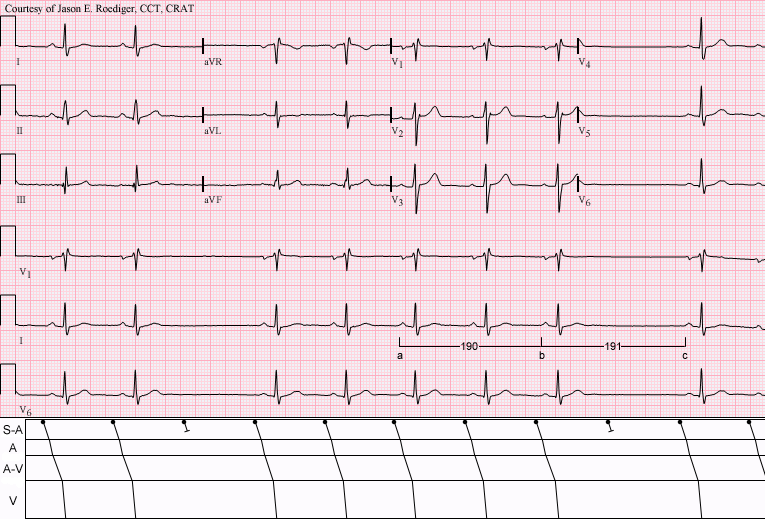Difference Between Sinus Arrest and Sinus Block
Key Difference – Sinus Arrest vs Sinus Block
SA node is an important part of the conducting system of the heart. It generates electrical impulses that are transmitted throughout the myocardium. In sinus arrest, this generation of impulses stops due to various pathological conditions. Defects in the transmission of impulses generated in the SA node are the cause of sinus block. Accordingly, in sinus arrest, electrical impulses are not properly generated whereas in sinus block, although there is no problem with the production of electrical signals, the signals are not properly transmitted into the myocardial cells. This is the key difference between these two conditions.
CONTENTS
1. Overview and Key Difference
2. What is Sinus Arrest
3. What is Sinus Block
4. Similarities Between Sinus Arrest and Sinus Block
5. Side by Side Comparison – Sinus Arrest vs Sinus Block in Tabular Form
6. Summary
What is Sinus Arrest?
Sinus arrest is due to the sudden cessation of the generation of impulses by SA node for more than 2 seconds. Due to the lack of electrical signals coming from the SA node the contraction of cardiac muscles also stops. Consequently, cardiac output decreases resulting in a drop in blood pressure too. If impulses are not generated for a period of more than 6 seconds, emergency procedures have to be initiated to protect the patient’s life.
Causes
- Hypoxia
- Myocardial ischemia
- Hyperkalemia
- Adverse effects of some drugs

Figure 01: ECG Changes in Sinus Arrest
Management
If there is an increase in the vagal stimulation, it is recommended to observe the patient for at least a day rather than promptly jumping into treatments. Any underlying pathology has to be aptly treated.
What is Sinus Block?
In some rare conditions, the entrance of the impulses from sinoatrial node (SA node) into the atrial muscles is blocked. This is clinically identified as a sinus block. In an ECG this condition is characterized by the absence of a P wave which is accompanied by the relaxation of the atrial muscles. But surprisingly, due to the lack of impulses propagating via SA node, AV node starts to produce its own impulses. This results in the contraction of ventricles in a slow but steady rhythm giving rise to a prolonged but otherwise unaltered QRS complex.
There are three main categories of sinus block namely,
First-degree Sinus Block
There is a delay in the transmission of impulses into the atria, but no impulses are blocked. This does not produce detectable ECG changes.
Second-degree Sinus Block
Second-degree blocks are again divided into two subcategories,
There is a gradual increase in the duration between the generation of impulses and their propagation into the atria which ultimately results in the blockage of an impulse passing onto the atria.
The time gap between the generation of impulses and their propagation onto the atria is prolonged, but it remains constant. An occasional impulse is lost without being transmitted to the atria.
Third-degree Sinus Block
None of the impulses are conducted into the atria.
Causes of Sinus Block

Figure 02: ECG Changes in Sinus Block
Clinical features include bradycardia and those due to the decreased cardiac output such as fatigue and faintishness.
Symptomatic sinus block has to be treated by the implantation of an artificial pacemaker.
What are the Similarities Between Sinus Arrest and Sinus Block?
- In both conditions, there is an impairment of the electrical activity of the heart.
- The usual symptoms of sinus arrest and sinus block are bradycardia, fatigue, faintishness
What is the Difference Between Sinus Arrest and Sinus Block?
Sinus Arrest vs Sinus Block | |
| Sinus arrest is due to the sudden cessation of the generation of impulses by SA node for more than 2 s. | Sinus block is due to the blockage of the transmission of impulses from SA node to the atria. |
| SA node | |
| Impulses are not generated by the SA node. | Impulses are generated by the SA node. |
| Causes | |
Sinus arrest is due to,
| Causes of sinus block are,
|
| Treatment | |
| If there is an increase in the vagal stimulation, the patient should be observed for at least a day. Any underlying pathology has to be aptly treated. | Symptomatic sinus block has to be treated by the implantation of an artificial pacemaker. |
Summary – Sinus Arrest vs Sinus Block
Sinus arrest and sinus block are two conditions which are due to the dysfunction of the SA node. The sinus arrest is due to the cessation of the firing of SA node whereas sinus block is due to the blockage of the electrical impulses generated by the SA node. So the difference between these two conditions is, in sinus arrest the pathology is in the generation of electrical impulses but in sinus block, pathology lies in their transmission.
Download the PDF Version of Sinus Arrest vs Sinus Block
You can download PDF version of this article and use it for offline purposes as per citation note. Please download PDF version here Difference Between Sinus Arrest and Sinus Block
Reference:
1.Kumar, Parveen J., and Michael L. Clark. Kumar & Clark clinical medicine. Edinburgh: W.B. Saunders, 2009.
2.Hall, John E., and Arthur C. Guyton. Guyton and Hall textbook of medical physiology. 12th ed. Philadelphia, PA: Elsevier, 2016. Print.
Image Courtesy:
1.’De-Rhythm sinusarrest (CardioNetworks ECGpedia)’ By CardioNetworks, (CC BY-SA 3.0) via Commons Wikimedia
2.’Type II S-A block’ By Jer5150 – Own work, (CC BY-SA 3.0) via Commons Wikimedia
ncG1vNJzZmivp6x7pbXFn5yrnZ6YsqOx07CcnqZemLyue8OinZ%2Bdopq7pLGMm5ytr5Wau26%2FyKesrGWRp7%2Bmv9NmmKecXavAbr%2FIp6ysZZKhvKS3jg%3D%3D